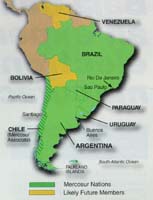
Surging free trade is rapidly changing the business fortunes of much of South America. Four nations — Argentina, Brazil, Paraguay and Uruguay — are aligned in the Mercosur customs union. And on Oct. 1, the Mercosur quartet added important ?associate member? Chile, Latin America?s most advanced economy. Bolivia will also likely soon join Mercosur, with Venezuela later following suit. With some 225 million consumers and US$1 trillion in gross domestic product (GDP), Mercosur has dramatically shuffled the global business location deck. Some 95 percent of intra-Mercosur trade is duty-free, with all remaining tariffs slated to fall by Dec. 31, 1999. Only 40 percent of ?associate member? Chile?s Mercosur trade is tariff-free, but most other duties will phase out over the next eight years. In fact, with Mercosur?s snowballing expansion, South America?s GDP growth will rank No. 2 in the world by the year 2000, trailing only the Asia-Pacific, industry analysts predict. ?Things have not changed as fast as I would like, but they have changed quicker than I expected,? says Rafael Birmann, president of Birmann SA, one of South American?s largest real estate services firms, headquartered in Brazil?s massive capital of Sao Paulo (population: 17 million). But Mercosur?s changes have made it the world?s hottest trade bloc. ?NAFTA started hot and then slowed down,? says Eduardo Herzog, president of the Sao Paulo brokerage firm of Herzog Imobiliaria. ?Mercosul started slow, and then picked up speed.? (In Portuguese-speaking Brazil, the word is Mercosul.) A New Location LandslideIntra-Mercosur trade has supplied much of that growth, soaring from 1990?s $4 billion to 1995?s $25 billion (including Chile). But new facilities are also moving into Mercosur at a dizzying clip, with the auto industry exhibit A. Since December 1995, more than a dozen Asian, European and U.S. manufacturers have announced $13 billion in major new Mercosur location projects. However, Mercosur?s magnetism — its snowballing free trade and an alluring, upwardly mobile market — spans the multinational business spectrum. 1996 foreign investment in Brazil alone will likely top $6.5 billion, doubling 1995?s record-setting totals. Federal Express, for instance, is enjoying double-digit Latin American business growth. Bank of Boston has ?seen tremendous growth, an eightfold increase in our assets since 1991,? says Fernando Martinez de San Vincente, Buenos Aires-based head of company engineering. Corporate location strategies have shifted dramatically within South America?s brave new business world. But cross-border locations by locally based companies have also skyrocketed, particularly within the bellwether Brazilian and Argentine markets. Real Estate: ?An Inflationary Hedge?Locally based firms have also undergone a vast change in asset management strategies. Consider the joint venture formed between U.S.-based Nike and Alpargatas, Argentina?s 113-year-old top dog in textiles and footwear.
But in an object lesson for potential outside investors, Nike rapidly jump-started Alpargatas? operations. Technology played an obvious transformational role. But so, too, did Nike?s dramatically different management techniques, which echo South American businesses? huge operational changes. In 1994 Nike extended Alpargatas? marketing rights through 1999 inside the 162 million-consumer Brazilian market. That?s made Brazil a big part of Alpargatas? strategic location plans. ?We have already opened a warehouse/distribution facility in Sao Paulo, and we?re considering opening a factory in northern Brazil,? says Ricardo Garat, Alpargatas? head of strategic planning. The Joint Venture ImperativeMany South American insiders see joint ventures as essential for South American success. ?Like all cultures, South America is unique,? says Birmann, who has formed alliances with two U.S.-based firms: Turner Construction and Compass Asset Management Services. ?It?s very hard to come in alone from the outside and understand the market and how business is done. People in different cultures may say something but mean something altogether different.? One major service provider recently spurned the joint-venture route, going it alone in South America. ?They couldn?t do it,? Birmann says. ?They?re not in business in South America any more.? Growing Political StabilityMercosur may also drive a final silver stake through the heart of South America?s historic instability. Consider the events of April 1996, when Mercosur virtually propped up the wavering regime of Paraguay President Juan Carlos Wasmosy. As fired Gen. Lino Ovideo threatened a coup, Mercosur ministers converged in Paraguay. If Ovideo executed his coup, they told him, Mercosur would expel Paraguay, leaving it a crippled economic outcast. The general meekly slunk away to retirement. Then, at their June 1996 summit, Mercosur?s four presidents added a key clause to the 1991 Treaty of Asuncion that created Mercosur, stipulating that democracy was an ?essential agreement? for membership. South America?s business community is well aware of the subcontinent?s enduring stereotypes — and well aware they?re changing. Reform has come more slowly in Brazil, Mercosur?s economic fulcrum. Plano Real only stabilized prices in 1994, three years after Argentina, which has shaved inflation from 1993?s 7.4 percent to 1996?s anticipated 0.8 percent. But Brazil?s business climate has dramatically improved, says John Mein of the American Chamber of Commerce-Sao Paulo. ?Up until 1994, business management here was very frequently management through surprises,? he says. ?But very substantive policy changes have made Brazil a strong business location. We?re only two years into economic stabilization, however. It will be another five to 10 years before it?s fully effective, when people no longer believe there will be inflation.? Doubts will persist about Mercosur?s economic stability until state reform is completed — and until events like the ?94 Mexican peso crash prove otherwise. Problem AreasIndeed, the Mercosur business climate is not problem-free. Significant gaps remain, including:
|
 Subscribe to Site Selection Magazine
Subscribe to Site Selection MagazineFeedback]|[
Search for
any topic]
Copyright 1996 Conway Data, Inc. All rights reserved
Legal Notice: Because data comes from many sources, Conway Data
can assume no responsibility for accuracy or currency.


